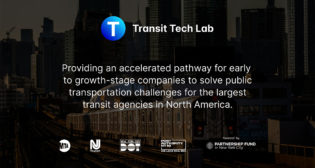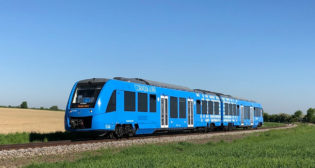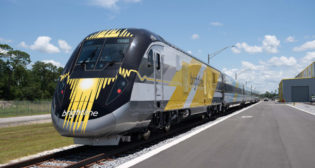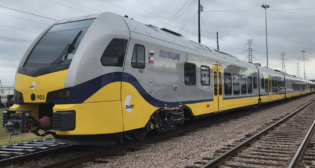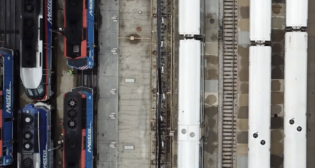
A Tale of Twin Cities
Written by David Peter Alan, Contributing Editor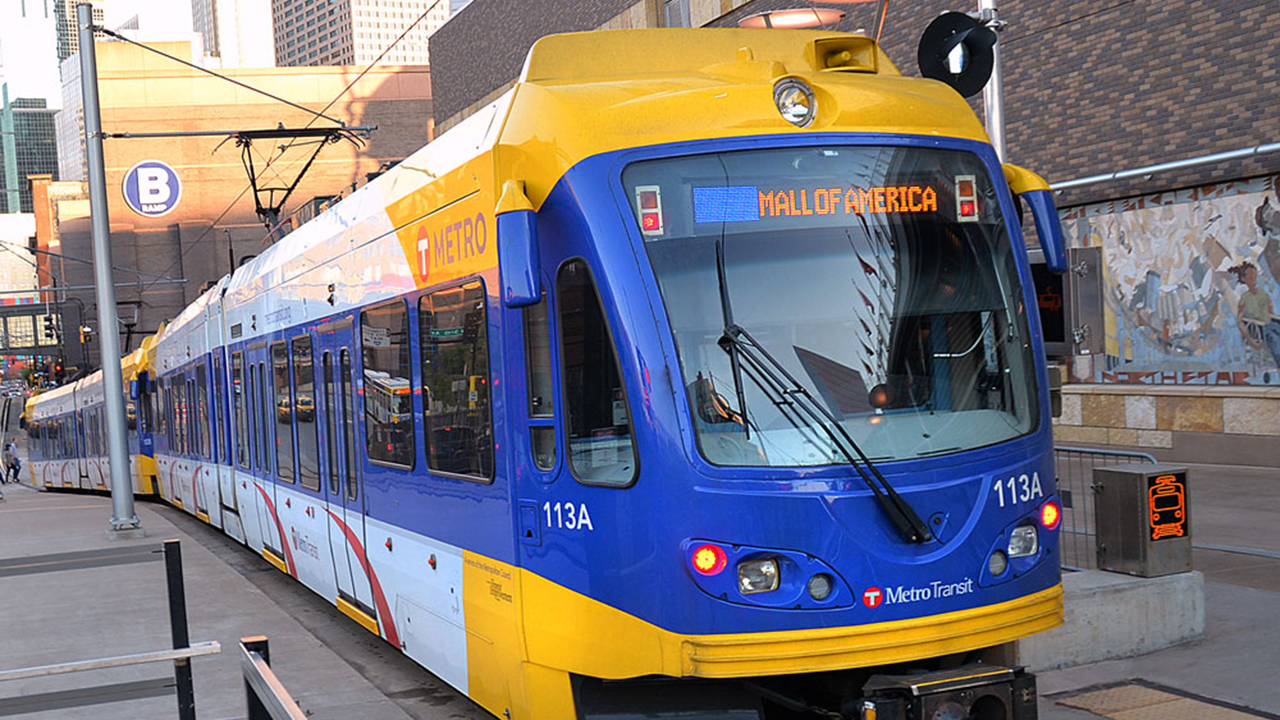
Metro Transit photo.
Rail transit systems around the United States and Canada are varied, from the huge subway system in New York City, to the “jurisdictional jumble” that drives Metrorail in Washington D.C., to the quaint part-time circulator line in Kenosha, Wisc. that uses 1940s-vintage PCC streetcars that once ran in Toronto. The same goes for local passenger railroads, from large legacy systems to lines for a few commuters.
One exception to that rule (or lack of same) occurs in the Midwest, where several cities have light rail or streetcar lines, but only one or two of them. That characteristic applies to Cincinnati, Milwaukee, Detroit, St. Louis and Kansas City. It also holds for the “Twin Cities” of Minneapolis and Saint Paul in Minnesota, with its two light rail lines. At the same time, the state hosts very few passenger trains.
Minnesota’s two largest cities are definitely fraternal twins. They have different styles. Minneapolis is the state’s largest city, with a rich industrial history. Saint Paul is smaller, serves as the state capital, and features classic residential areas like Summit Avenue. They are about ten miles apart. An LRT trip with multiple stops requires 47 minutes to cover the distance between the Minneapolis end of the line at Target Field to the Saint Paul end at Union Depot.
Rail Transit Comes Back
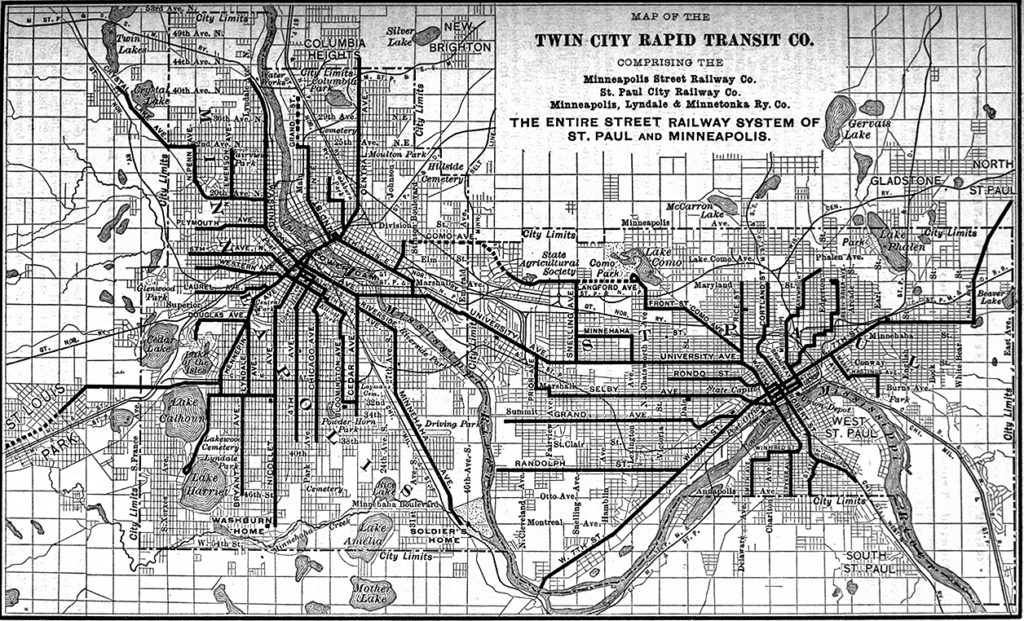
Streetcars first appeared in both Minneapolis and Saint Paul during the last third of the 19th century. The Twin City Rapid Transit Company, also known as Twin City Lines, ran streetcars from the 1890s until 1954 and, as happened almost everywhere, buses were added, eventually replacing the streetcars. The decline began in 1949, and the last streetcars ran on June 19, 1954. Many of the last cars on the property, all PCC types, ended up in Newark. They were operated by Public Service Coordinated Transport on the Newark City Subway, the sole survivor of a once-vast streetcar network in the Garden State. NJ Transit was founded to take over that line and the former Public Service bus routes in 1980, and it operated the former Twin Cities cars until Aug. 24, 2001. Some of those cars are running today in trolley museums or on Market Street in San Francisco. For example, some were sold to Mexico City, and two eventually returned to Minnesota from Newark. The 322 runs on the Como-Harriet Streetcar Line, and a sister car is a parts store. (More on historic preservation below.)
In 1967, after the cars were gone, the Minnesota Legislature established the Metropolitan Transit Commission (MTC). That agency kept the buses running through the years but did not re-establish rail transit. When the agency was renamed Metro Transit in 1997, there was renewed interest in bringing light rail to the metropolitan area, perhaps spurred by the success of that mode in other cities.
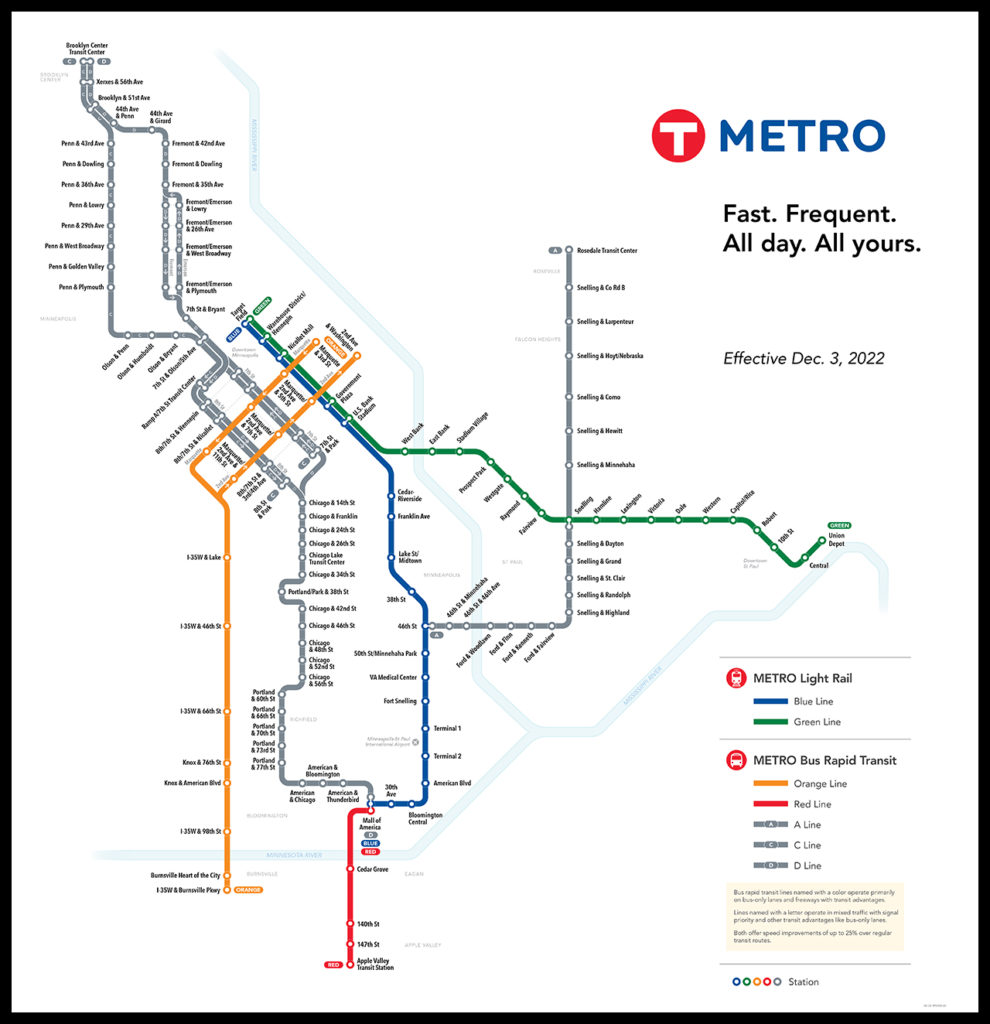
The first LRT, the Hiawatha Corridor, a twelve-mile line in Hennepin County, opened for service on June 26, 2004, 50 years plus one week after the previous incarnation of streetcars ended. The line runs between downtown Minneapolis and the Mall of America in Bloomington, adjacent and parallel to Hiawatha Blvd. It was originally designated as “Route 55” because Hiawatha Blvd. carries Minnesota State Hwy. 55. Today, that track is owned by CPKC (CP until the recent merger), and Amtrak’s Empire Builder runs on it. Also, much of the light rail line runs along Hiawatha Avenue. A short extension to Target Field, where the Minnesota Twins play, opened in 2009. In 2013, Metro Transit renamed the line the Blue Line. It operates with Alstom (originally Bombardier) Flexity Swift LF-70s and Siemens S70 LRVs painted in a blue, yellow and white scheme.
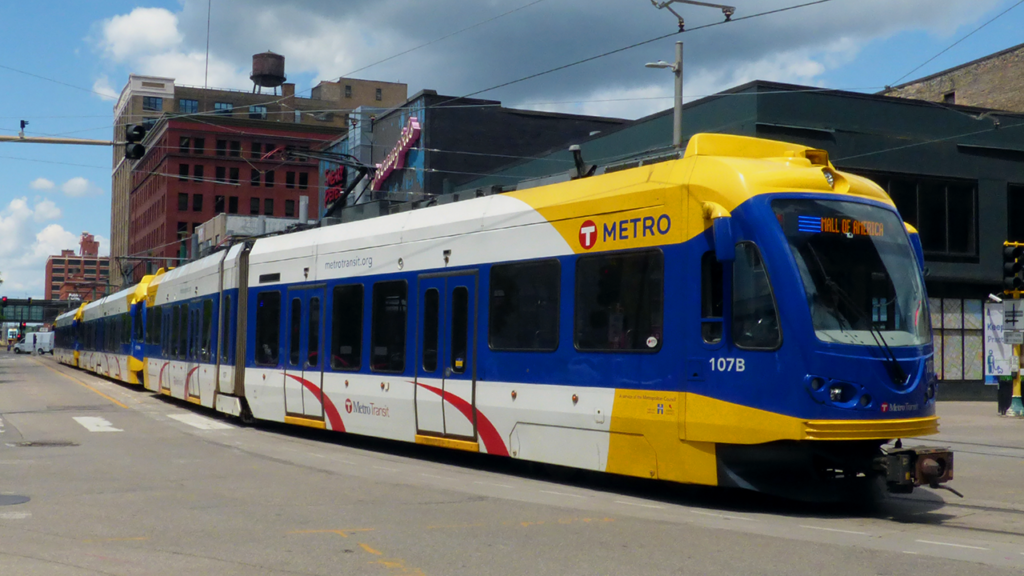
There is an extension planned for the Blue Line: the Bottineau LRT. It will run north of downtown Minneapolis and slightly west, ending up in Brooklyn Park. A trip between there and Target Field is expected to take 29 minutes. At first, the line was planned as a busway, but a local push for rail and expectations of significantly stronger ridership moved planners and officials to select the LRT option.
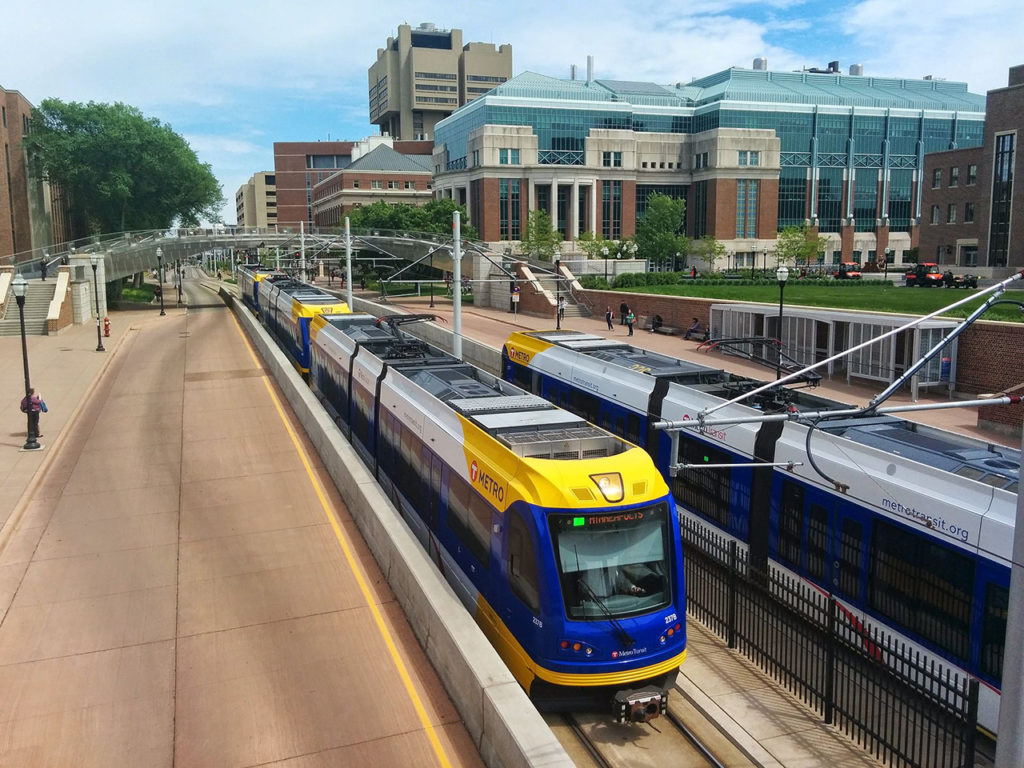
The other LRT in the system is the Green Line, which connects downtown Minneapolis with downtown Saint Paul, and both with the University of Minnesota campus. The eleven-mile line runs along University Avenue in Saint Paul and Washington Avenue from downtown Minneapolis to the campus and was originally called the Central Corridor. Construction on the line began in 2010, and it opened for service on June 14, 2014. A ride from end to end is scheduled to take 46 minutes. It operates with Siemens S70 LRVs.
A Green Line extension now under construction is projected to open for service in 2027. It is the 14.5-mile Southwest LRT, which will run from Target Field in downtown Minneapolis to Eden Prairie and will include 16 stations. A trip along the extension is expected to take 32 minutes. The original 2009 study called for the line to be completed in 2015, but construction did not begin until late 2018. Some of the delays have been attributed to neighborhood opposition and funding difficulties.
The Green Line terminates directly in front of Saint Paul Union Depot, a classic station from 1923 that features a head house with monumental architecture and a waiting room with a vaulted ceiling. It is used as a public lounge or an event hall at different times. The tracks are located below the station building and, at the present time, the Empire Builder is the only train that calls there. There might be more in the future but, even now, the opportunity to get off a train, walk out the front door of the station and get onto frequent, full-service rail transit is an experience reminiscent of travel from another era that is not currently available in many cities in the U.S. or Canada.
The system’s two light rail lines share five stations in downtown Minneapolis, from Target Field to US Bank Station. They split east of there, with the Blue Line going in a southerly direction toward the Mall and the Green Line going in an easterly direction toward Saint Paul.
Few Passenger Trains
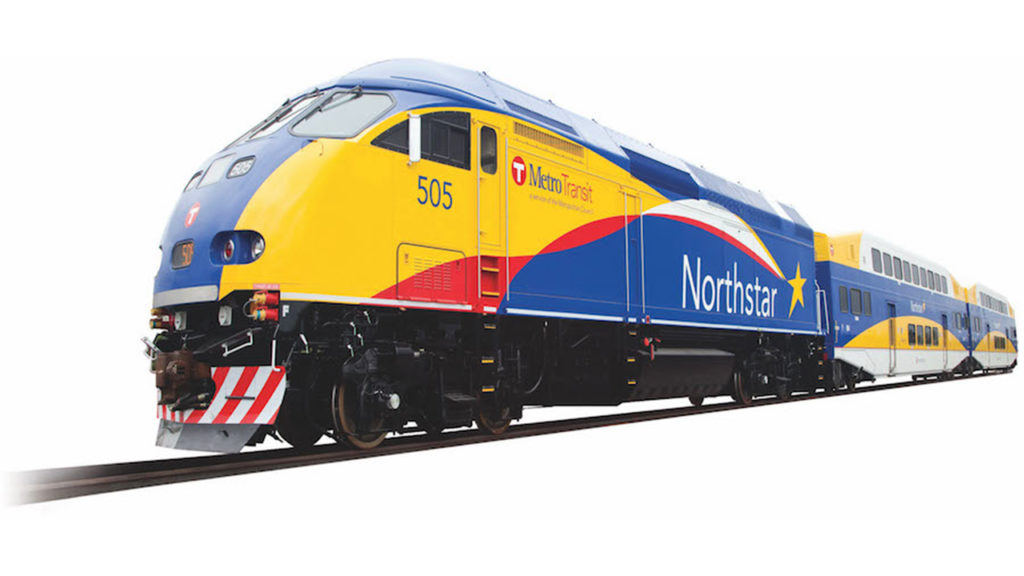
Minneapolis and Saint Paul have a rich railroad history. The Milwaukee Road, Burlington Route, Chicago & North Western, Chicago Great Western and Soo Line all ran passenger trains between there and Chicago. The Minneapolis & St. Louis also ran passenger trains, but they did not reach Chicago. Other trains went west on the Northern Pacific (NP) and Great Northern (GN), both of which are now part of BNSF. Some of them went as far as such West Coast cities as Seattle, Tacoma and Portland. There were trains north to Winnipeg, Manitoba for connections across Canada, and trains to other U.S. Midwestern cities. Today, Amtrak’s Empire Builder, named after James J. Hill, who founded the GN and after 1900 controlled the NP, is the only intercity train left.
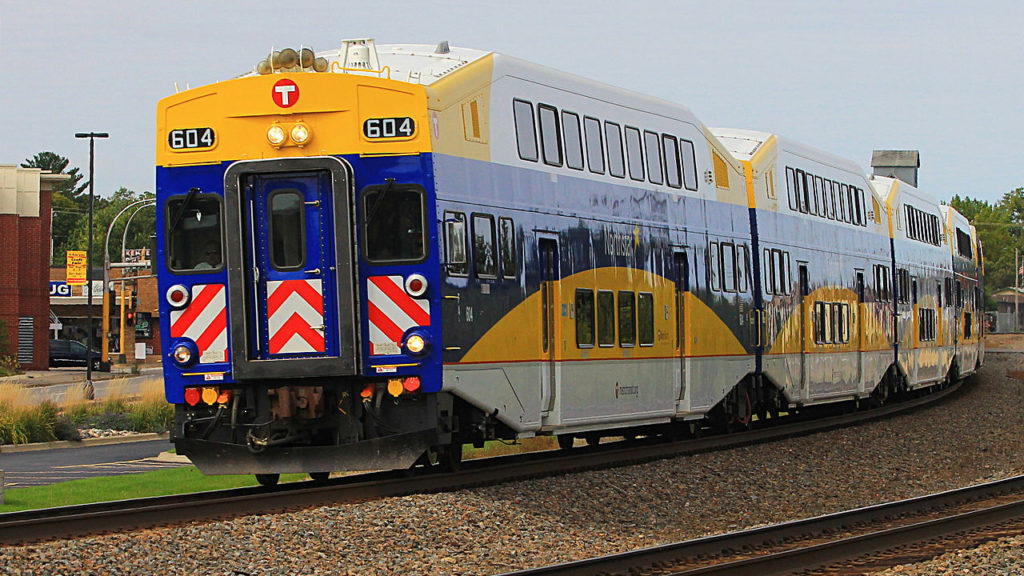
There isn’t much local service, although there have been discussions from time to time about adding more. The Minnesota Department of Transportation published a Commuter Rail System Plan in February 2000. It proposed six lines radiating in different directions, one going north of Saint Paul and the other five centered on Minneapolis. In 2002, the legislature prohibited funding for the Dan Patch Corridor south of Minneapolis (though that was repealed this year; see below), and all except one of the other lines met similar fates: going nowhere.
Minnesota is known as the North Star State, and the Northstar Corridor on an alignment northwest of the cities is the only proposed line where service operates today. Although Northstar Line trains run 40 miles from Target Field Station (with connections to both light rail lines), much of the route runs on the historic NP track used by the Empire Builder going to or from St. Cloud. Northstar Line trains have never run to St. Cloud, only reaching as far as Big Lake, with a connecting bus to or from Becker and St. Cloud station. The line was originally planned in 1997, state funding was approved in 2006, and federal funds came in 2007. Local funding was also secured, including some from the Minnesota Twins for station improvements, and the line opened on Nov. 16, 2009. Reports from that time in the Star-Tribune indicate that ridership was below expected levels.
The trains are powered by MotivePower (Wabtec) MP36PH-3C locomotives, and consist of Alstom (again, originally Bombardier) BiLevel cars of the type common in the U.S. and Canada outside the Northeast Corridor and Chicago. The original schedule included five weekday round trips in the prevailing commuting direction, and one running in the reverse-commute direction from Minneapolis in the morning and toward it in the late afternoon. Becker and St. Cloud still have a connecting bus at Big Lake. There were also three trains in each direction on weekends, with different schedules on Saturdays and Sundays.
Most of those trains were taken off the rails when the COVID-19 virus struck in 2020. That happened in many places, as Railway Age and its sibling publications reported at the time. Over the past three years, we also reported on how the return of service on rail transit and regional rail ike the Northstar Line was progressing. Service on that line was slashed to two trains into Minneapolis in the morning, and back out to Big Lake in the late afternoon, with buses for St. Cloud. At this writing, that schedule is still in effect. There were also trains for special events, but those are not running now, either. Other minor commuter operations have returned to pre-COVID schedules.
Metro Transit’s website, features a video on How to Ride Northstar, and calls the train “the relaxing way from the northwest suburbs to downtown.” However, there are few opportunities to enjoy the ride and the relaxation. Northstar now offers less service than any other commuter rail line in the nation. Will there eventually be more? Time will tell, and there is talk of extending service beyond St. Cloud along the “Builder Route” to Morehead and Fargo, across the Missouri River in North Dakota. Still, Northstar has not recovered any service that was discontinued due to the COVID-19 virus, which makes it appear unlikely that more trains will be added anytime soon.
Historic Preservation
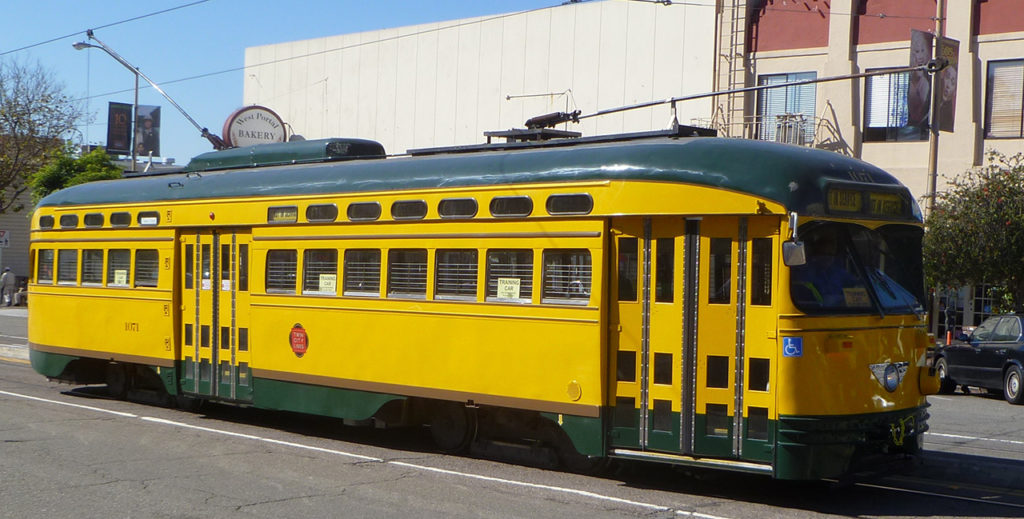
The region does pay tribute to its railroad and transit history. The Minnesota Transportation Museum (MTM) operates a railroad museum at the Jackson Street Roundhouse in Saint Paul. It also operates the Minnihaha Depot, a former station in a local park accessible by light rail on the Blue Line. Its tourist railroad, the Osceola & St. Croix Valley Railway, is in Wisconsin.
The Minnesota Streetcar Museum split off from the MTM in 2004. It operates the Como-Harriet Streetcar Line in Minneapolis, using vintage cars that originally ran on the Twin Cities system. The museum also operates a shorter line in the suburb of Excelsior, on Lake Minnetonka. It runs Car 78 from the Duluth Street Railway Company, which entered service in 1893 and was originally retired in 1911. Until 2019, the line connected with the Minnihaha, one of the “streetcar boats” built in 1906 and scuttled in 1928. Supporters hope to run excursions on the lake with the Minnihaha in the future.
State Rail Plan
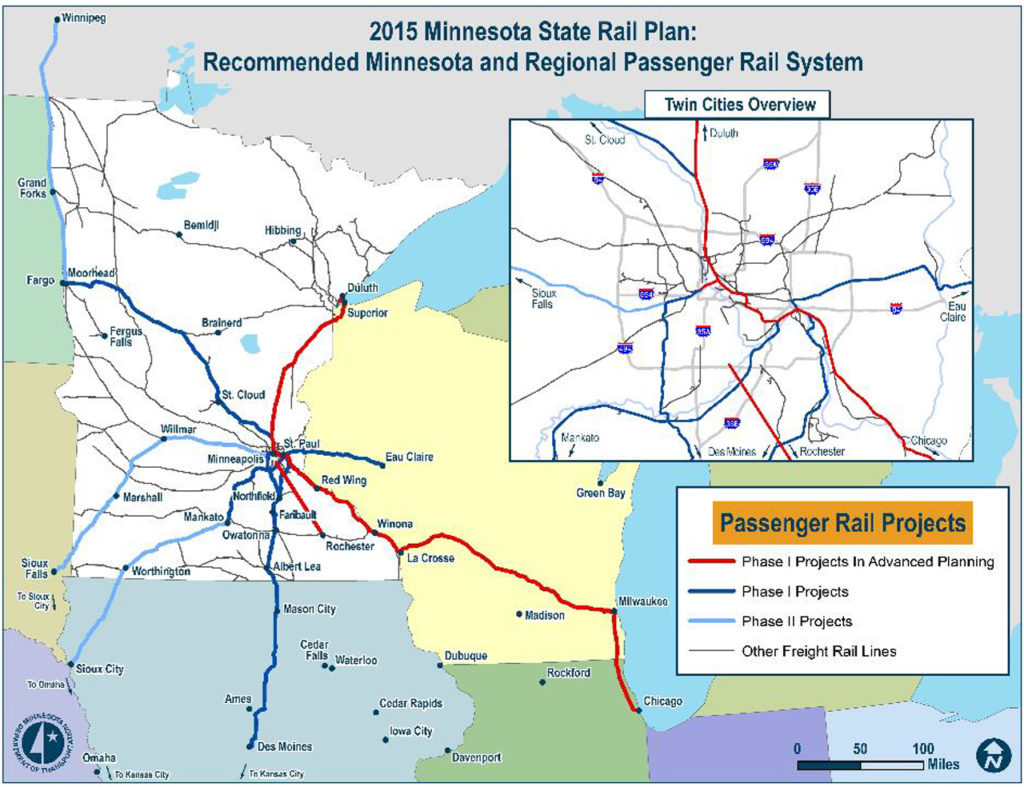
While locals in the region and tourists who visit there can get a taste of railroad and streetcar history, it is appropriate to conclude this article with a look at the future of passenger trains in a place where there are few running today. As we noted, the 2000 plan for a regional rail network has not fared well.
An ambitious State Rail Plan from 2015 (download below) proposed a number of corridor-length routes for passenger trains throughout much of Minnesota and into neighboring states that, if service is established, would create a number of mobility opportunities for non-motorists and motorists alike. Three projects were in advanced planning at the time: a second frequency between Chicago and the Twin Cities, service to Duluth, and service to Rochester, home of the Mayo Clinic. Other projects within a 20-year planning frontier included service to Albert Lea and Des Moines, Mankato, Fargo/Moorhead, and Eau Claire, Wisc. Plans beyond the 20-year frontier included service to Sioux Falls, S.Dak., an extension from Mankato to Sioux City, Iowa, and an extension northward form Fargo/Moorhead to Winnipeg, Manitoba.
Jay Severance, a retired planning and operations executive and board member of the advocacy organization All Aboard Minnesota, made the case for an even-more-ambitious network at streets.mn during the darkest days of the COVID-19 era, on May 6, 2020. The additional routes that he proposed include going south from Des Moines to Kansas City, also going south from Sioux Falls to Omaha, a second route between Chicago and the Twin Cities through Madison and Eau Claire, and restoration of a long-distance train on the route of the old North Coast Limited (historic NP), which was eliminated in 1979. These proposals include those in the 2015 State Rail Plan and suggest intercity routes beyond it. MnDOT is now accepting comments for a new State Rail Plan scheduled to be released in 2025.
There is movement on some proposals for increased passenger train service in Minnesota. The proposed Northern Lights Express (NLE) would run 155 miles between Target Field Station (not Saint Paul) to Duluth. There would be four daily trains in each direction, with intermediate stops at Coon Rapids, Cambridge, Hinckley, and Superior, Wisc. There have been discussions about the proposed service since before 2000, but the Minnesota Legislature came up with funding last year. The previous passenger train on the route was the North Star, which started in 1978 as an overnight train between Chicago and Duluth, was cut back to running only north of the Twin Cities in 1980, and ended its life in 1985 running only on weekends (Friday evening, and Saturday and Sunday day trips).
There might be some new life for a former proposal to run to Rochester, known as the Rochester Rail Link and Zip Rail. There have been several feasibility studies (download one from TEMS conducted for the Minnesota DOT below) concerning the proposed 100-mile run, the last of which was discontinued in 2016. On May 21, 2023, the Legislature passed a transportation bill that repealed the gag order that had shut down the 2016 study, along with the 2002 ban on studying the Dan Patch Corridor south of Minneapolis. The former passenger service to Rochester ended in 1963.
The project most on track for implementation is the second frequency between Chicago and St. Paul. Service could start as soon as next year on a northbound schedule about three hours ahead of the current Empire Builder and a southbound schedule about three hours behind it. Some advocates have called for an early morning departure from Chicago, an afternoon turn at Saint Paul, and a late evening arrival back in Chicago, to offer a better choice of departure times and improve equipment utilization. It appears that the proposed train will be next to come onto the rails in Minnesota.
At one time, Minnesota and its cities offered far more mobility on the rails than they offer today. There might be a few improvements in the offing, but a strong passenger train and rail transit network is decades off, and subject to the risks and uncertainties that come with a long planning frontier. On the local scene in Minneapolis and Saint Paul, there are two light rail lines providing frequent service. It’s not much in cities where buses dominate, and there are five express BRT (bus rapid transit) lines, compared to the two rail lines and a commuter rail line that is doing very poorly, at least as of this writing. Nonetheless, in a city that has faced many challenges in the past few years, the most notable being the murder of George Floyd and its aftermath, the Blue and Green Lines are allowing a diverse population to get around the two cities frequently and in comfort. There are many other cities where rail transit is not doing even that well, and many more that have no rail transit at all.
